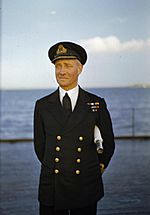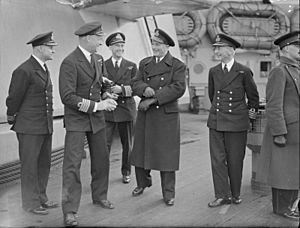Philip Mack facts for kids
Quick facts for kids
Philip John Mack
|
|
|---|---|

Mack onboard HMS King George V in 1942
|
|
| Born | 6 October 1892 Paston Hall, Paston, Norfolk |
| Died | 29 April 1943 (aged 50) |
| Buried |
Saint Margaret's church, Paston, Norfolk
|
| Allegiance | |
| Service/ |
|
| Years of service | 1905–1943 |
| Rank | Rear admiral |
| Commands held |
|
| Battles/wars | |
| Awards |
|
Philip John Mack (born October 6, 1892 – died April 29, 1943) was a brave officer in the British Royal Navy. He became a Rear Admiral and was known for his leadership during both World War I and World War II. He even received a special award called the Distinguished Service Order for his courage.
Contents
Philip John Mack grew up in Paston, Norfolk, England. His father was Major Philip Paston Mack.
Young Philip joined the Navy when he was just 13 years old, on September 15, 1905. He started as a naval cadet at special naval colleges like Osborne and Britannia Royal Naval College. These schools trained young people to become naval officers.
After his training, he served on different ships. In 1910, he joined the battlecruiser Indomitable. Later, in 1913, he moved to the cruiser Amethyst.
World War I Service
When World War I began in 1914, Philip Mack was promoted to lieutenant. He served on several ships during the war, including the torpedo-boat destroyer Tigress and the battleship Lord Nelson.
He also served on River Clyde, a ship that was used to land soldiers during the Gallipoli campaign in 1915. He later had to return home due to illness.
From January to April 1917, he commanded a special type of ship called a Q-ship. These were disguised merchant ships that secretly carried weapons to trick enemy submarines. His ship, the Result, even fought and damaged a German submarine called UC-45. For his bravery, he received a special mention called a Mention in Despatches in April 1917.
Between the Wars
After World War I, Philip Mack continued to rise through the ranks. He became a lieutenant commander in 1922. He commanded destroyers like the Tumult and Wishart in the Mediterranean Fleet.
He also served as the executive officer (second-in-command) on the heavy cruiser Hawkins in China. In 1927, he was promoted to commander. He then commanded another destroyer, Wryneck.
From 1930, he worked at the Admiralty, which is like the Navy's headquarters. Later, he returned to sea as the executive officer of the battleship Nelson. In 1934, he became a captain. Before World War II, he also worked as a naval attaché in Buenos Aires, Argentina. This meant he represented the British Navy there.
World War II Service
When World War II began, Captain Mack was put in charge of the 7th Destroyer Flotilla (a group of destroyers) in the Home Fleet. He commanded the destroyer Jervis. For a short time, he commanded Janus while Jervis was being repaired after a collision.
He then moved to the Mediterranean Fleet and became the Captain (D) of the 14th Destroyer Flotilla. He earned the Distinguished Service Order (DSO) in July 1940 for his excellent leadership.
He showed great bravery during important naval battles. In April 1941, he led his flotilla in the Battle of the Tarigo Convoy, where they attacked enemy ships. For this, he received a bar to his DSO, meaning he got the award a second time. He also received another Mention in Despatches for his role in the Battle of Cape Matapan in March 1941.
In May 1942, he took command of the battleship King George V. He was promoted to rear admiral in January 1943.
Sadly, Rear-Admiral Mack was killed in an air crash on April 29, 1943. He is buried in St. Margaret Churchyard in Paston, the same place where he grew up.
Family Life
In 1930, Philip Mack married Elizabeth Dawson. Her family was from Shanghai, China.
Philip also had two younger brothers, Richard Herbert Mack and Edward Mack. Both of them also served in the Royal Navy during World War II and were recognized for their service.


